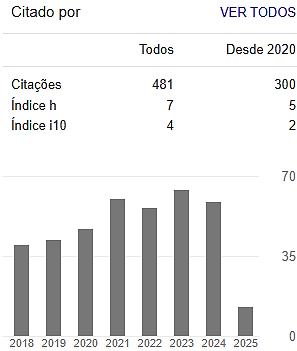DETECÇÃO DE FALHAS ESTRUTURAIS EM UM PORTICO METÁLICO UTILIZANDO A COMPUTAÇÃO INTELIGENTE
Keywords:
Detecção de Falhas, Monitoramento de Integridade Estrutural, Sistema Imunológico ArtificialAbstract
The Metal Gantries is one of the main structural compositions of gas stations, bridges and sky spiders. However, such structures are vulnerable to environmental, temporal and anthropological demands, generating wear and tear that can cause these structures to collapse. With the technological advances of the Fourth Industrial Revolution, there was a transformation of the relationship between physical space and man, called the Cyber-Physic model. This technological evolution surpassed the walls of Industries 4.0, and was also established in the civil branch, solving the problems of structural insecurity, reciprocal to the metallic portico through the Structural Health Monitoring Therefore, this research work presents an innovative proposal for the development of a Structural Health Monitoring applied to Metal Gantries with decision making based on Intelligent Computing. With this, this work seeks not only to implement the Structural Health Monitoring to guarantee safety in metallic frames, but also to optimize its operation with decision making based on the Artificial Immune System, through the Negative Selection Algorithm. Observing the results, this work proved to be efficient, robust and economically viable, having a high performance, representing the perfect Cyber-Physic measure in the monitoring of Metal Gantries and resolution of its structural problems.
Downloads
References
Abreu, C. C. E., Chavarette, F. R., Alvarado, F. V., Duarte, M. A. Q., Lima, F. P. A., 2014, Dual-Tree Complex Wavelet Transform Applied to Fault Monitoring and Identification in Aeronautical Structures, International Journal of Pure and Applied Mathematics 97, 89-97. DOI: 10.12732/ijpam. v97i1.9 https://doi.org/10.12732/ijpam.v97i1.9
Atalla, Noureddine e Sgard, Franck. Finite element and boundary methods in structural acoustics and vibration. CRC Press, 2015. https://doi.org/10.1201/b18366
Bradley, D.W. and Tyrrell, A.M. (2002), “Immunotronics – novel finite-state-machine architectures with built-in self-test using self-nonself differentiation”, IEEE Transactions on Evolutionary Computation, Vol. 6 No. 3, pp. 227-238. https://doi.org/10.1109/TEVC.2002.1011538
Chen, Y. and Li, Y. (2018), Computational Intelligence Assisted Design in Industrial Revolution 4.0, CRC Press, Boca Raton, p. 527. https://doi.org/10.1201/9781315153179
Dasgupta, D. and Niño, L.F. (2009), Immunological Computation: Theory and Applications, Taylor and Francis Group, Boca Raton, p. 298. https://doi.org/10.1201/9781420065466
De Castro, L.N. and Timmis, J. (2003), “Artificial immune systems as a novel soft computing paradigm”, Soft Computing Journal, Vol. 7 No. 8, pp. 526-544. https://doi.org/10.1007/s00500-002-0237-z
Deraemaeker, A. and Worden, K. (2010), New Trends in Vibration Based Structural Health Monitoring, SpringerWien, NewYork, p. 311. https://doi.org/10.1007/978-3-7091-0399-9
Dhapekar, N. K.; Chopkar, D. M. Structural health monitoring of ordinary portland cement concrete structures using X-ray diffraction. International Journal of Applied Engineering Research, v. 11, n. 9, p. 6128-6131, 2016.
Farrar, C.R. and Worden, K. (2013), Structural Health Monitoring: A Machine Learning Perspective, John Wiley, Chichester, p. 643. EC. https://doi.org/10.1002/9781118443118
Forrest, S., Perelson, A.S., Allen, L. and Cherukuri, R. (1994), “Self-nonself discrimination in a computer”, Proceeding of the IEEE Symposium on Research in Security and Privacy, Oakland, pp. 202-212. https://doi.org/10.1109/RISP.1994.296580
Gopalakrishnan, S., Ruzzene, M. and Hanagud, S. (2011), Computational Techniques for Structural Health Monitoring, Springer-Verlag, London, p. 517. https://doi.org/10.1007/978-0-85729-284-1
Ilhan, A., Mehmet, K., Ebru, K. and Erhan, A. (2018), “A new fault diagnosis approach for induction motor using negative selection algorithm and its real-time implementation on FPGA”, Journal of Intelligent and Fuzzy Systems, Vol. 34 No. 1, pp. 689-701. https://doi.org/10.3233/JIFS-161964
Lima, F.P.A., Chavarette, F.R., Souza, A.S.E., Souza, S.S.F. and Opes, M.L.M. (2013), “Artificial imune systems with negative selection applied to health monitoring of aeronautical structures”, Advanced Materials Research, Vol. 871, pp. 283-289. https://doi.org/10.4028/www.scientific.net/AMR.871.283
Magruk, A., 2016. Uncertainty in the Sphere of the Industry 4.0–Potential Areas to Research. Business, Management and Education 14(2), 275-291. DOI:10.3846/bme.2016.332. https://doi.org/10.3846/bme.2016.332
Moro, T. C., Chavarette, F. R., Roéfero, L. G. P., & Outa, R. (2019, November). Detection of Structural Failure of a Two Floor Building Using an Artificial Immunological System. In Colloquium Exactarum. ISSN: 2178-8332 (Vol. 11, No. 4, pp. 73-84). https://doi.org/10.5747/ce.2019.v11.n4.e298
Popkova, E.G., Ragulina, Y.V. and Bogoviz, A.V. (2019), Industry 4.0: Industrial Revolution of the 21st Century, Springer International, p. 249. https://doi.org/10.1007/978-3-319-94310-7
Snedecor, G. W., Cochram, W. G., 1989, Statistical Methods, 8rd ed. Iowa: Iowa State University Press.

